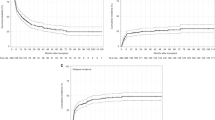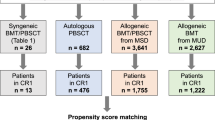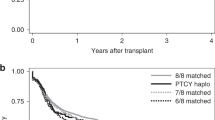Abstract
This study was performed to investigate incidence, causes and factors influencing mortality after haploidentical hematopoietic stem cell transplantation (HSCT) and to compare differences between haploidentical HSCT and HLA-identical sibling HSCT. From January 2000 to June 2011, 1411 patients with acute leukemia or myelodysplastic syndrome were included in this study. Of these patients, 571 received HLA-identical sibling HSCT and 840 received haploidentical HSCT. The cumulative incidence of overall mortality and transplant-related mortality (TRM) after haploidentical HSCT was higher than those after HLA-identical sibling HSCT (38.7% vs 33.3%, P=0.012 and 27.5% vs 19.9%, P=0.002), but the incidence of relapse-related mortality (RRM) did not differ between the two groups (15.6% vs 16.7%, P=0.943). A multivariate analysis suggested that high-risk disease status and haploidentical HSCT correlated with a higher incidence of overall mortality (P<0.0001, hazard ratio=1.911 and P=0.019, hazard ratio=1.249); in addition, in haploidentical HSCT, only high-risk disease status correlated with a higher incidence of overall mortality (P<0.0001, hazard ratio=1.845). Our study suggested that haploidentical HSCT provided a higher incidence of overall mortality and TRM but the same incidence of RRM compared with HLA-identical sibling HSCT. Therefore, HLA-identical sibling HSCT remains the first choice, but haploidentical HSCT is available for patients without an HLA-identical sibling donor.
This is a preview of subscription content, access via your institution
Access options
Subscribe to this journal
Receive 12 print issues and online access
$259.00 per year
only $21.58 per issue
Buy this article
- Purchase on Springer Link
- Instant access to full article PDF
Prices may be subject to local taxes which are calculated during checkout


Similar content being viewed by others
References
Gooley TA, Chien JW, Pergam SA, Hingorani S, Sorror ML, Boeckh M et al. Reduced mortality after allogeneic hematopoietic-cell transplantation. N Engl J Med 2010; 363: 2091–2101.
Horan JT, Logan BR, Agovi-Johnson MA, Lazarus HM, Bacigalupo AA, Ballen KK et al. Reducing the risk for transplantation-related mortality after allogeneic hematopoietic cell transplantation: how much progress has been made? J Clin Oncol 2011; 29: 805–813.
Giebel S, Labopin M, Holowiecki J, Labar B, Komarnicki M, Koza V et al. Outcome of HLA-matched related allogeneic hematopoietic stem cell transplantation for patients with acute leukemia in first complete remission treated in Eastern European centers. Better results in recent years. Ann Hematol 2009; 88: 1005–1013.
Lu DP, Dong L, Wu T, Huang XJ, Zhang MJ, Han W et al. Conditioning including antithymocyte globulin followed by unmanipulated HLA-mismatched/haploidentical blood and marrow transplantation can achieve comparable outcomes with HLA-identical sibling transplantation. Blood 2006; 107: 3065–3073.
Mehta J, Singhal S, Gee AP, Chiang KY, Godder K, Fv Rhee Fv et al. Bone marrow transplantation from partially HLA-mismatched family donors for acute leukemia: single-center experience of 201 patients. Bone Marrow Transplant 2004; 33: 389–396.
Ciceri F, Labopin M, Aversa F, Rowe JM, Bunjes D, Lewalle P et al. A survey of fully haploidentical hematopoietic stem cell transplantation in adults with high-risk acute leukemia: a risk factor analysis of outcomes for patients in remission at transplantation. Blood 2008; 112: 3574–3581.
Bethge WA, Faul C, Bornhäuser M, Stuhler G, Beelen DW, Lang P et al. Haploidentical allogeneic hematopoietic cell transplantation in adults using CD3/CD19 depletion and reduced intensity conditioning: an update. Blood Cells Mol Dis 2008; 40: 13–19.
Luznik L, O'Donnell PV, Symons HJ, Chen AR, Leffell MS, Zahurak M et al. HLA-haploidentical bone marrow transplantation for hematologic malignancies using nonmyeloablative conditioning and high-dose, posttransplantation cyclophosphamide. Biol Blood Marrow Transplant 2008; 14: 641–650.
Kato S, Yabe H, Yasui M, Kawa K, Yoshida T, Watanabe A et al. Allogeneic hematopoietic transplantation of CD34+ selected cells from an HLA haplo-identical related donor. A long-term follow-up of 135 patients and a comparison of stem cell source between the bone marrow and the peripheral blood. Bone Marrow Transplant 2000; 26: 1281–1290.
Walker I, Shehata N, Cantin G, Couture F, Dhédin N, Barty R et al. Canadian multicenter pilot trial of haploidentical donor transplantation. Blood Cells Mol Dis 2004; 33: 222–226.
Wang Y, Liu DH, Xu LP, Liu KY, Chen H, Zhang XH et al. Prevention of relapse using granulocyte CSF-primed PBPCs following HLA-mismatched/ haploidentical, T-cell-replete hematopoietic SCT in patients with advanced-stage acute leukemia: a retrospective risk-factor analysis. Bone Marrow Transplant 2012; 47: 1099–1104.
Yan CH, Liu DH, Liu KY, Xu LP, Liu YR, Chen H et al. Risk stratification-directed donor lymphocyte infusion could reduce relapse of standard-risk acute leukemia patients after allogeneic hematopoietic stem cell transplantation. Blood 2012; 119: 3256–3262.
Yan CH, Wang JZ, Liu DH, Xu LP, Chen H, Liu KY et al. Chemotherapy followed by modified donor lymphocyte infusion as a treatment for relapsed acute leukemia after haploidentical hematopoietic stem cell transplantation without in vitro T-cell depletion: superior outcomes compared with chemotherapy alone and an analysis of prognostic factors. Eur J Haematol 2013; 91: 304–314.
Tomas ED, Storb R, Clift RA, Fefer A, Johnson L, Neiman PE et al. Bone marrow transplantation. N Engl J Med 1975; 292: 895–902.
Sun Y, Xu L, Liu D, Zhang X, Han W, Wang Y et al. Incidence of invasive fungal disease after unmanipulated haploidentical stem cell transplantation was significantly higher than that after HLA-matched sibling transplantation. Clin Microbiol Infect 2013; 19: 1029–1034.
Han TT, Xu LP, Liu DH, Liu KY, Zhang XH, Chen H et al. Prevalence of EBV infection in patients with allogeneic hematopoietic stem cell transplantation. Zhonghua Xue Ye Xue Za Zhi 2013; 34: 651–654.
Huang JJ, Lu XQ, Yan CH, Zhao XS, Xu LP, Huang XJ et al. Comparative study on clinical features of cytomegalovirus infection after allogenic hematopoietic stem cell transplantation from HLA haploidentical related donors vs HLA-matched sibling donors. Chin J Organ Transpl 2013; 34: 234–239.
Castagnola E, Bagnasco F, Amoroso L, Caviglia I, Caruso S, Faraci M et al. Role of management strategies in reducing mortality from invasive fungal disease in children with cancer or receiving hemopoietic stem cell transplant: a single center 30-year experience. Pediatr Infect Dis J 2014; 33: 233–237.
Omer AK, Ziakas PD, Anagnostou T, Caviglia I, Caruso S, Faraci M et al. Risk factors for invasive fungal disease after allogeneic hematopoietic stem cell transplantation: a single center experience. Biol Blood Marrow Transplant 2013; 19: 1190–1196.
Chang YJ, Zhao XY, Huo MR, Xu LP, Liu DH, Liu KY et al. Immune reconstitution following unmanipulated HLA-mismatched/haploidentical transplantation compared with HLA-identical sibling transplantation. J Clin Immunol 2012; 32: 268–280.
Zhao XS, Xu LP, Liu DH, Han T, Wang Y, Zhang X et al. A comparison of clinical characteristics and prognosis of adult acute graft-versus-host disease between human leukocyte antigen-identical and -mismatched allogenic hematopoietic stem cell transplantation. Chin J Intern Med 2014; 53: 35–40.
Xu LL, Zhao XY, Huang XJ . Effects of rhG-CSF mobilization on Th17 cells in donors' peripheral blood and bone marrow grafts. Zhongguo Shi Yan Xue Ye Xue Za Zhi 2010; 18: 1548–1551.
Huang XJ, Chang YJ, Zhao XY . Maintaining hyporesponsiveness and polarization potential of T cells after in vitro mixture of G-CSF mobilized peripheral blood grafts and G-CSF primed bone marrow grafts in different proportions. Transpl Immunol 2007; 17: 193–197.
Huang XJ, Chang YJ, Zhao XY . In vivo induction of T-cell hyporesponsiveness and alteration of immunological cells of bone marrow grafts using granulocyte colony-stimulating factor. Haematologica 2004; 89: 1517–1524.
Chen SH, Li X, Huang XJ . Effect of recombinant human granulocyte colony-stimulating factor on T-lymphocyte function and the mechanism of this effect. Inter J Hematol 2004; 79: 178–184.
Rutella S, Zavala F, Danese S, Kared H, Leone G . Granulocyte colony-stimulating factor: a novel mediator of T cell tolerance. J Immunol 2005; 175: 7085–7091.
Zhang C, Zhang X, Chen XH . Cellular mechanism for granulocyte-colony stimulating factor in the prevention of graft-versus-host disease in combined bone marrow and peripheral blood transplantation for hematological malignancies: the composition in collection. Transfus Apher Sci 2013; 48: 3–9.
Liu YC, Lu PL, Hsiao HH, Chang CS, Liu TC, Yang WC et al. Cytomegalovirus infection and disease after allogeneic hematopoietic stem cell transplantation: experience in a center with a high seroprevalence of both CMV and hepatitis B virus. Ann Hematol 2012; 91: 587–595.
Wang Y, Liu DH, Xu LP, Liu KY, Chen H, Chen YH et al. Superior graft-versus-leukemia effect associated with transplantation of haploidentical compared with HLA-identical sibling donor grafts for high-risk acute leukemia: an historic comparison. Biol Blood Marrow Transplant 2011; 17: 821–830.
Kanda Y, Chiba S, Hirai H, Sakamaki H, Iseki T, Kodera Y et al. Allogeneic hematopoietic stem cell transplantation from family members other than HLA-identical siblings over the last decade (1991-2000). Blood 2003; 102: 1541–1547.
Sierra J, Pérez WS, Rozman C, Carreras E, Klein JP, Rizzo JD et al. Bone marrow transplantation from HLA-identical siblings as treatment for myelodysplasia. Blood 2002; 100: 1997–2004.
Castro-Malaspina H, Harris RE, Gajewski J, Ramsay N, Collins R, Dharan B et al. Unrelated donor marrow transplantation for myelodysplastic syndromes: outcome analysis in 510 transplants facilitated by the National Marrow Donor Program. Blood 2002; 99: 1943–1951.
Alessandrino EP, Della Porta MG, Bacigalupo A, Van Lint MT, Falda M, Onida F et al. WHO classification and WPSS predict post transplant outcome in patients with myelodysplastic syndrome: a study from the GITMO (gruppo italiano trapianto di midollo osseo). Blood 2008; 112: 895–902.
Author information
Authors and Affiliations
Corresponding author
Ethics declarations
Competing interests
The authors declare no conflict of interest.
Additional information
Author contributions
X-J Huang participated in the designation of the research; C-H Yan participated in the writing of the manuscript and data analysis; all others participated in providing patient data.
Rights and permissions
About this article
Cite this article
Yan, CH., Xu, LP., Wang, Fr. et al. Causes of mortality after haploidentical hematopoietic stem cell transplantation and the comparison with HLA-identical sibling hematopoietic stem cell transplantation. Bone Marrow Transplant 51, 391–397 (2016). https://doi.org/10.1038/bmt.2015.306
Received:
Revised:
Accepted:
Published:
Issue Date:
DOI: https://doi.org/10.1038/bmt.2015.306
This article is cited by
-
Clinical risk factors and prognostic model for patients with bronchiolitis obliterans syndrome after hematopoietic stem cell transplantation
Bone Marrow Transplantation (2024)
-
Predicting the loss of hepatitis B surface antigen following haematopoietic stem cell transplantation in patients with chronic HBV infection
Bone Marrow Transplantation (2023)
-
Meta-analysis of the results of haploidentical transplantation in the treatment of aplastic anemia
Annals of Hematology (2023)
-
Risk stratification system for skin and soft tissue infections after allogeneic hematopoietic stem cell transplantation: PAH risk score
Frontiers of Medicine (2022)
-
The immediate impact of physical function and quality of life after hematopoietic stem cell transplantation
Supportive Care in Cancer (2022)



